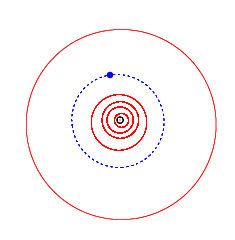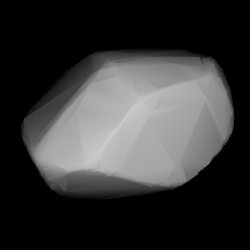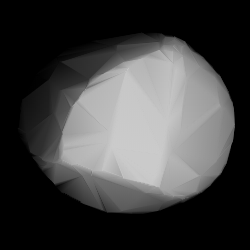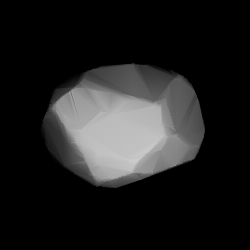Related Research Articles
2575 Bulgaria, provisional designation 1970 PL, is a stony Florian asteroid from the inner regions of the asteroid belt, approximately 7 kilometers in diameter. It was discovered on 4 August 1970, by Russian astronomer Tamara Smirnova at the Crimean Astrophysical Observatory in Nauchnyj, on the Crimean peninsula. It was named for country Bulgaria.
6433 Enya, provisional designation 1978 WC, is a stony background asteroid from the inner regions of the asteroid belt, approximately 7 kilometers in diameter. It was discovered on 18 November 1978, by Czech astronomer Antonín Mrkos at the Kleť Observatory in the Czech Republic. It was named for Irish musician Enya.

9968 Serpe, provisional designation 1992 JS2, is an asteroid from the middle regions of the asteroid belt, approximately 12 kilometers in diameter.
1931 Čapek, provisional designation 1969 QB, is a background asteroid from the central regions of the asteroid belt, approximately 7 kilometers in diameter. It was discovered on 22 August 1969, by Czech astronomer Luboš Kohoutek at the Bergedorf Observatory in Hamburg, Germany. The asteroid was named in memory of Czech writer Karel Čapek.
1910 Mikhailov, provisional designation 1972 TZ1, is a carbonaceous asteroid from the outer regions of the asteroid belt, approximately 35 kilometers (22 mi) in diameter. Discovered at Nauchnyj in 1972, it was named after Russian astronomer Aleksandr Aleksandrovich Mikhailov. It has a 3:1 ratio of iron to carbon, hence the name. The asteroid is believed to have been expelled from its parent asteroid belt (one of three main asteroid belts in the inner Solar System), and is classified as a metallic asteroid, because its iron is fairly weak.
2153 Akiyama, provisional designation 1978 XD, is a carbonaceous Themistian asteroid from the outer region of the asteroid belt, approximately 17 kilometers in diameter.
7385 Aktsynovia, provisional designation 1981 UQ11, is a background asteroid from the inner regions of the asteroid belt, approximately between 4 and 9 kilometers in diameter, depending on its assumed spectral type. It was discovered on 22 October 1981, by Soviet–Russian astronomer Nikolai Chernykh at the Crimean Astrophysical Observatory in Nauchnyj on the Crimean peninsula.

1905 Ambartsumian, provisional designation 1972 JZ, is an asteroid from the inner regions of the asteroid belt, approximately 8 kilometers in diameter. It was discovered on 14 May 1972, by Russian astronomer Tamara Smirnova at the Crimean Astrophysical Observatory, Nauchnyj, on the Crimean peninsula. The asteroid was named after theoretical astrophysicist Victor Ambartsumian.
1956 Artek, provisional designation 1969 TX1, is a dark Themistian asteroid from the outer regions of the asteroid belt, approximately 19 kilometers in diameter. It was discovered on 8 October 1969, by Soviet–Russian astronomer Lyudmila Chernykh at the Crimean Astrophysical Observatory in Nauchnyj. It was named after Artek, a Soviet Young Pioneer camp.
4391 Balodis, provisional designation 1977 QW2, is a dark and rare Erigone asteroid from the inner regions of the asteroid belt, approximately 8 kilometers in diameter. It was discovered by Soviet–Russian astronomer Nikolai Chernykh at the Crimean Astrophysical Observatory in Nauchnyj, on the Crimean peninsula, on 21 August 1977. The asteroid was named for Latvian geodesist Jānis Balodis.

1804 Chebotarev is a stony background asteroid from the inner regions of the asteroid belt, approximately 10 kilometers in diameter. It was discovered on 6 April 1967, by Russian astronomer Tamara Smirnova at the Crimean Astrophysical Observatory in Nauchnyj on the Crimean peninsula. The asteroid was named after Soviet astronomer G. A. Chebotarev.
2032 Ethel, provisional designation 1970 OH, is a dark background asteroid from the outer regions of the asteroid belt, approximately 36 kilometers in diameter. It was discovered on 30 July 1970, by Soviet astronomer Tamara Smirnova at the Crimean Astrophysical Observatory in Nauchnyj, on the Crimean peninsula. The asteroid was named after Irish writer Ethel Voynich.
5316 Filatov, provisional designation 1982 UB7, is a carbonaceous asteroid and potentially slow rotator from the outer region of the asteroid belt, approximately 30 kilometers in diameter.
2892 Filipenko, provisional designation 1983 AX2, is a carbonaceous asteroid from the outer region of the asteroid belt, approximately 60 kilometers in diameter.
11949 Kagayayutaka, provisional designation 1993 SD2, is a stony background asteroid from the outer region of the asteroid belt, approximately 23 kilometers (14 miles) in diameter. It was discovered on 19 September 1993, by Japanese amateur astronomers Kin Endate and Kazuro Watanabe at Kitami Observatory in eastern Hokkaidō, Japan. The asteroid was named after Japanese artist Kagaya Yutaka.
4822 Karge, provisional designation 1986 TC1, is a bright asteroid from the inner regions of the asteroid belt, approximately 4 kilometers in diameter. It was discovered on 4 October 1986, by American astronomer Edward Bowell at the Anderson Mesa Station of the Lowell Observatory in Flagstaff, Arizona. The asteroid was later named after American physics teacher Orville Karge.

1855 Korolev (prov. designation: 1969 TU1) is a stony Flora asteroid from the inner regions of the asteroid belt, approximately 7 kilometers in diameter. Discovered in 1969, it was later named after Soviet rocket engineer Sergei Korolev.

1904 Massevitch is a background asteroid from the central region of the asteroid belt. It was discovered on 9 May 1972, by the Russian astronomer Tamara Smirnova at the Crimean Astrophysical Observatory in Nauchnyj, on the Crimean peninsula. The uncommon R-type asteroid has a rotation period of 5.3 hours and measures approximately 16 kilometers in diameter. It was later named after Russian astrophysicist Alla Masevich.

1793 Zoya, provisional designation 1968 DW, is a stony Florian asteroid from the inner regions of the asteroid belt, approximately 9 kilometers in diameter. It was discovered on 28 February 1968, by Russian astronomer Tamara Smirnova at the Crimean Astrophysical Observatory in Nauchnyj, on the Crimean peninsula, and named after World War II partisan Zoya Kosmodemyanskaya.
1856 Růžena, provisional designation 1969 TW1, is a stony asteroid from the inner regions of the asteroid belt, approximately 6.6 kilometers in diameter. It was discovered on 8 October 1969, by Russian astronomer Lyudmila Chernykh at Crimean Astrophysical Observatory in Nauchny, on the Crimean peninsula. The asteroid was named after Růžena Petrovicova, staff member at Kleť Observatory.
References
- 1 2 3 4 "JPL Small-Body Database Browser: 3710 Bogoslovskij (1978 RD6)" (2017-05-01 last obs.). Jet Propulsion Laboratory . Retrieved 16 June 2017.
- 1 2 3 Schmadel, Lutz D. (2007). "(3710) Bogoslovskij". Dictionary of Minor Planet Names – (3710) Bogoslovskij. Springer Berlin Heidelberg. p. 313. doi:10.1007/978-3-540-29925-7_3707. ISBN 978-3-540-00238-3.
- 1 2 Masiero, Joseph R.; Mainzer, A. K.; Grav, T.; Bauer, J. M.; Cutri, R. M.; Nugent, C.; Cabrera, M. S. (November 2012). "Preliminary Analysis of WISE/NEOWISE 3-Band Cryogenic and Post-cryogenic Observations of Main Belt Asteroids". The Astrophysical Journal Letters. 759 (1): 5. arXiv: 1209.5794 . Bibcode:2012ApJ...759L...8M. doi:10.1088/2041-8205/759/1/L8 . Retrieved 23 August 2016.
- ↑ "3710 Bogoslovskij (1978 RD6)". Minor Planet Center. Retrieved 16 June 2017.
- ↑ "LCDB Data for (3710) Bogoslovskij". Asteroid Lightcurve Database (LCDB). Retrieved 16 June 2017.
- ↑ "MPC/MPO/MPS Archive". Minor Planet Center. Retrieved 16 June 2017.